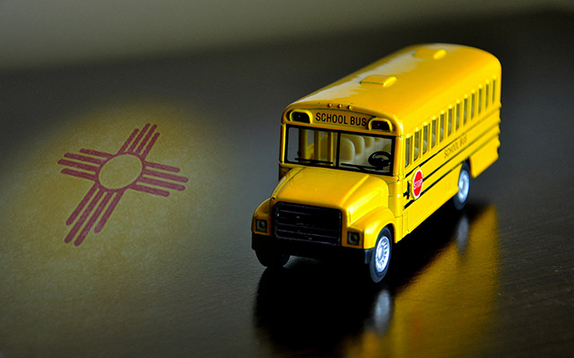Editor's note: This is part four in a four-part series examining the plight of education in New Mexico. Read Part I, Part II, and Part III.

Public education came late to New Mexico. As recently as 1888, the territory didn’t have a single public school or university. Public education did not become a universal right until a generation later when the new state’s constitution declared: “A uniform system of free public schools sufficient for the education of, and open to, all the children of school age in the state shall be established and maintained.”
The lack of a historical pedigree for public education may help explain the failure of the state’s public schools. That the schools are (with some notable exceptions) failing our students is a judgment that liberals and conservatives, Democrats and Republicans share. Using data from, among others, the U.S. Census Bureau, the National Center for Educational Statistics and the Institute of Museum and Library Services, WalletHub recently ranked New Mexico 46th overall in education among the 50 states and the District of Columbia. New Mexico placed 43rd in dropout rate, 47th in math test scores and 50th in reading test scores.
Such educational failures are nothing new in New Mexico. What has been new over the past seven years is the cutting of spending for an already underfunded education system. This year, New Mexico is increasing public school funding by $72 per pupil. But that is a drop in the bucket compared to the state’s $946 per-pupil cut over the previous five years. The result is that New Mexico schools have fewer teachers, larger classes and fewer programs than they did a decade ago.
There has been some discussion by pro-education groups of filing a lawsuit against the state arguing that it is violating the New Mexico Constitution by inadequately funding education. Such a suit, called the Lobato case, is currently before the courts in Colorado.
New Mexico has in some respects the worst education system in the U.S. Meanwhile, New Mexico by some measures is also the poorest state in the U.S. It is axiomatic in science that a correlation is not proof of causation. But it does make one wonder. Does poverty cause bad schools? Do bad schools cause poverty? Conversely, can good education reduce poverty? Can increasing prosperity lead to better education?
Students, schools and even whole countries (e.g. Finland, England, Cuba and South Korea) have dramatically improved education for underprivileged populations. Looking at their experience, some of my friends in education believe the cure for what ails us is better teaching. Others, however, particularly those on the front lines, insist that we already ask too much of our teachers, that they can’t solve societal problems in the classroom. Where is the solution, in the classroom or in society as a whole?
The argument that began as a disagreement over principle has often become personal and emotional, mired in ideology, bitterness and blindness to other points of view or degrading into a power struggle between school districts, historically the heart of public education, and state government, newly empowered by its control over school finances.
At the heart of the fight over education reform in New Mexico is Hanna Skandera, the controversial and divisive acting secretary of education. After nearly four years in office she is still “acting” secretary because the governor has been unable to get the Senate to confirm her appointment. Often the argument over Skandera’s policies is less about her policies than how she has gone about implementing them. It’s a bit like the Republicans’ attacks on how President Obama went about reforming immigration rather than opposing the substance of his reforms.
Here’s just one example of how Skandera’s approach to reform has undermined changes that could have been widely supported. Over the objections of nearly all teachers and principals and many school districts, she and the Public Education Department she heads have insisted on using student testing as 50 percent of the evaluations that determine the salaries and even the employment of teachers. Teachers have argued that the tests are not an accurate reflection of either learning or teaching.
Some teachers want the tests thrown out entirely, but many teachers, including some I interviewed for this series, recognize the value of testing but argue that the tests should have a lesser importance in the overall evaluation scheme. Even many legislators are dubious. Both Republican Sen. Gary Kernan and Democratic Rep. Mimi Stewart told Skandera at a November legislative hearing that the percentage should be decreased. However, Skandera announced in November that she would not compromise. The tests will count 50 percent in the next round of evaluations.
Skandera came to New Mexico from Florida, where a Republican administration then headed by Gov. Jeb Bush pushed through a series of education reforms including A-F grading of schools, charter school expansion, third-grade retention, massive student testing and teacher evaluations based on them. Skandera brought this agenda to New Mexico, where she has been widely accused of implementing them with a heavy hand, riding roughshod over school districts and teacher unions. One has to wonder if Jeb Bush wins the presidency in two years, as he is widely rumored to be interested in doing, whether he might appoint Skandrea to do for the nation what she has been doing in New Mexico.
The bad feelings between Skandra and many teachers and school districts extends to Skandera’s boss. Gov. Susana Martinez was quoted as telling a campaign strategy group: “During the campaign, we can’t say it, I guess, because it’s education, but I really keep going back to that . . . keeping the teachers from feeling the pain when they already don’t work, you know, two and a half months out of the year or three months out of the year but earn salaries at the same rate of people who do work 12 months a year.”
Like student testing and teacher evaluations, many of Skandera’s reforms are in essence popular, or at least would be if handled differently. The implementation has been, more often than not, the issue. Similar complaints have been made against other reforms she has proposed, such as not promoting third graders who cannot read.
In New Mexico, we know a lot more about failure than success, about what doesn’t work than what does. What we have learned is that single-shot panaceas fail. Any real and lasting solution has got to be complex, multifaceted and all-encompassing.
On her web site, Skandera asks, “What will it take to dramatically improve public education in New Mexico?” Based on research, interviews and lessons from the best and worst schools in New Mexico, here are 13 elements of such a solution:
1. Provide better teacher training at the college level with lots of hands-on classroom work and mentoring as well as preparation in specialized subjects. An essay in The New Yorker by James Surowiecki concluded:
“Teacher training in most of the United States has usually been an afterthought. Most new teachers enter the classroom with a limited set of pedagogical skills, since they get little experience beforehand, and most education courses don’t say much about how you run a class. Then teachers get little ongoing, sustained training to help them improve. If American teachers—unlike athletes or manufacturing workers—haven’t got much better over the past three decades, it’s largely because their training hasn’t, either.”
The essay continues: “Countries that perform exceptionally well in international comparisons—among them Finland, Japan, and Canada—all take teacher training extremely seriously. They train teachers rigorously before they get in the classroom, and they make sure that the training continues throughout their work lives.”
2. Retain good teachers while upgrading the skills of average and incompetent ones through teacher development and mentoring in the schools
3. Insist on parental and family involvement in children’s education, if necessary punishing parents who refuse to help their kids.
4. Offer highly skilled teachers more respect and higher salaries, comparable to what they could receive in other professions.
5. Require other institutions to support parents and schools—including the police, prosecutors, the Department of Children, Youth and Families, the courts, and agencies that administer anti-poverty programs in health, nutrition, recreation, summer jobs, before-and after-school activities and youth mentoring.
6. Offer free and universal daycare, early childhood education, preschools and kindergartens to help mothers work and to assist kids in overcoming the cultural and economic effects of impoverished families and communities.
7. Hold back third-graders who can’t read, but give schools more money to handle swollen third-grade classrooms as well as to prepare kids better in the earlier grades so few would have to be held back.
8. Use the Common Core as the basis of uniform national standards but make it more flexible by tailoring it to the needs of individual school districts, and soliciting a lot more local input.
9. Test teachers by testing students, but test the same students at the beginning and end of the school year, and reduce the percentage of teacher evaluations based on student testing to something less than the current 50 percent, perhaps 25 percent.
10. Upgrade student testing skills, teach them to use computers easily and make them fluent in English—and do it all before extensive testing is introduced into a classroom,
11. Admit that while money alone won’t fix education, starving schools of resources as New Mexico has done since 2007 won’t hack it either.
12. Encourage the growth of charter schools but with qualifications. Don’t hurt small schools by taking away their financing; promote charter schools for the most difficult populations (American Indians, Hispanics, inner cities) rather than having most focus on the easiest students, those who are college-bound or live in upscale neighborhoods; provide separate charter school funding so mainline public schools won’t feel they are being taken advantage of through a zero-sum game.
13. Give the best teachers handsome incentives to work in the most difficult schools. The $5,000 bonus that is available for a couple of schools isn’t doing the job. Even The powerful Legislative Finance Committee, in a report released at the end of October, said New Mexico needs to do more to put top teachers in the hardest jobs.
Almost all education experts agree that this combination of conservative and liberal policies could revolutionize learning and teaching. But it could still fall far short of making most of our kids into well-educated adults. To do that might require a second kind of revolution.
New Mexico has a couple of America’s richest counties and several of its poorest. It has the fourth-highest percentage of doctorates and one of the lowest percentages of bachelor’s and master’s degrees. It has residents on the Navajo Reservation living in conditions that were hardly imaginable in the 19th century, let alone the 21st, while towns like Santa Fe and Taos are fabled for their wealthy celebrity denizens. Taos Ski Valley voted to incorporate as the state’s newest municipality because it’s wealthy, Anglo and mostly elderly residents did not want to be taxed to support the impoverished, mostly Hispanic schools outside their prosperous enclave.
“Our schools and teachers have the extremely difficult challenge of educating a very large number of children who live in poverty,” according to a report in January by the New Mexico Center on Law and Poverty. “There is a large body of evidence showing that poverty directly impacts success in school. It is not coincidental that New Mexico ranks at the bottom of states both in terms of educational outcomes and in terms of the number of children living in poverty.”
But Skandera, the education policy maker, says on her web site, “I want the best teachers teaching our children and I want to reward outstanding educators who excel in their field. Lastly, I want options for parents to give them the choice to provide the best for their child.” Nowhere does she mention poverty. In her world, it would seem to be an irrelevance.
The Center on Law and Poverty report concludes:
In order to improve the educational outcomes in our schools, we must come to terms with the dynamics between poverty and learning. While New Mexico has demonstrated a commitment to equitably funding its schools, and while our teachers, according to both qualitative and quantitative analyses, are excellent, New Mexico has not addressed how our high rates of child poverty impact our education system. Hence, decades of attempts at education reform have yielded little success. Indeed, meeting the explicit needs of children living in poverty, and, at the same time, redoubling our efforts to reduce child poverty, are the best strategies for improving educational outcomes in New Mexico.
If the Center is right and Skandera wrong, it could be a long time before we get the schools we need and our kids deserve.
(Photos: School bus by peddhapati / CC; Zia symbol by Nicolas Raymond / CC)




Responses to “Education in New Mexico, Part 4: What is to be done?”